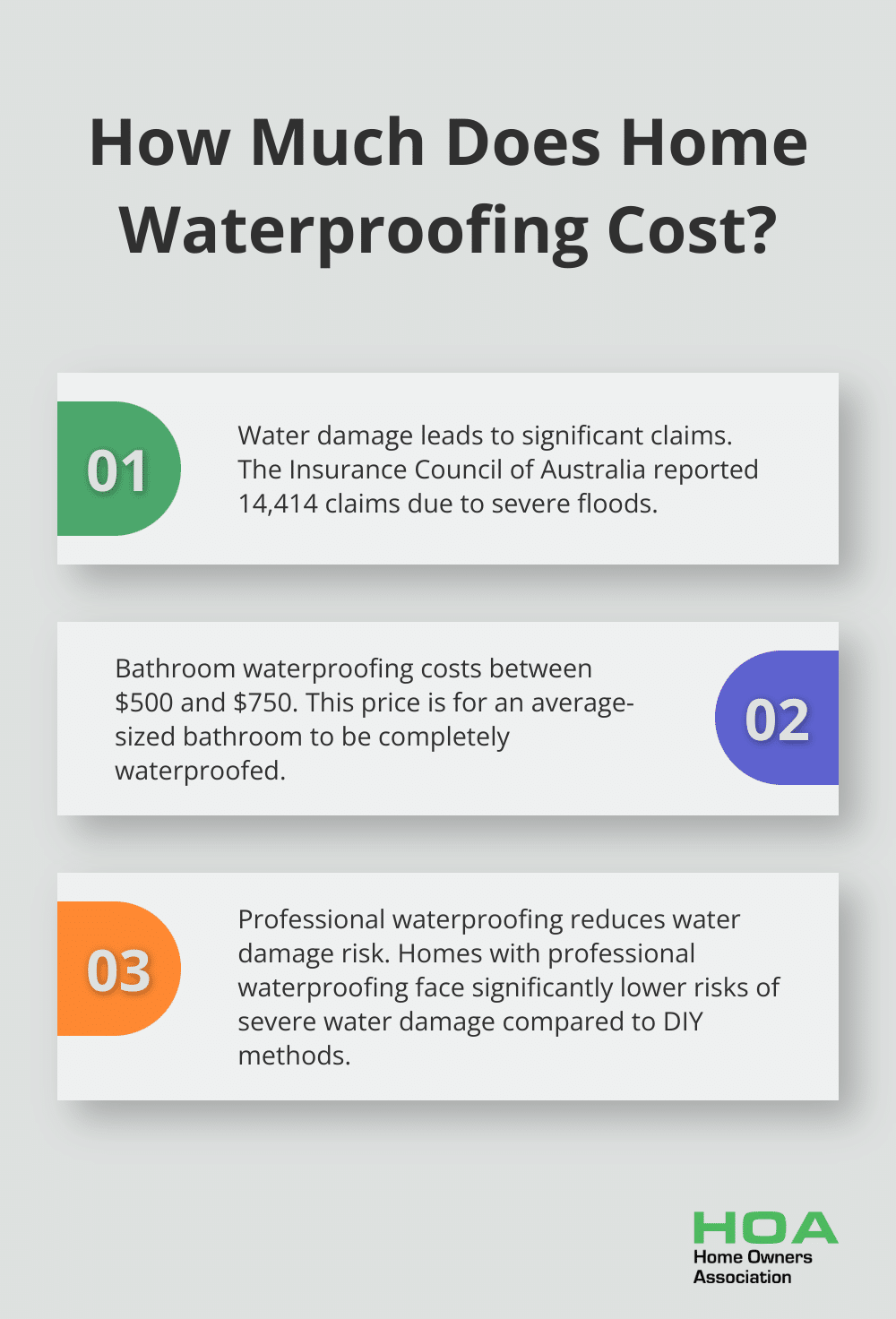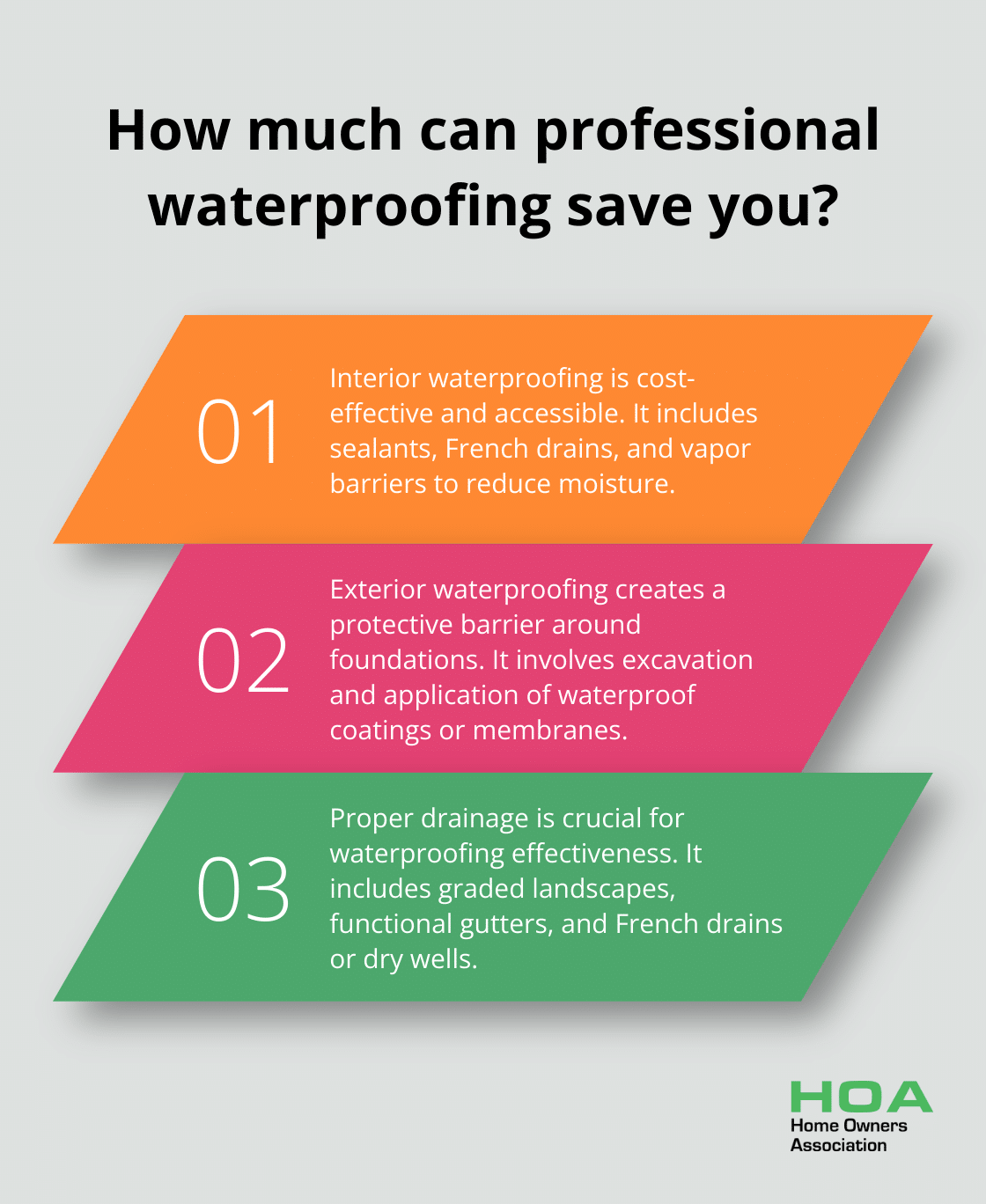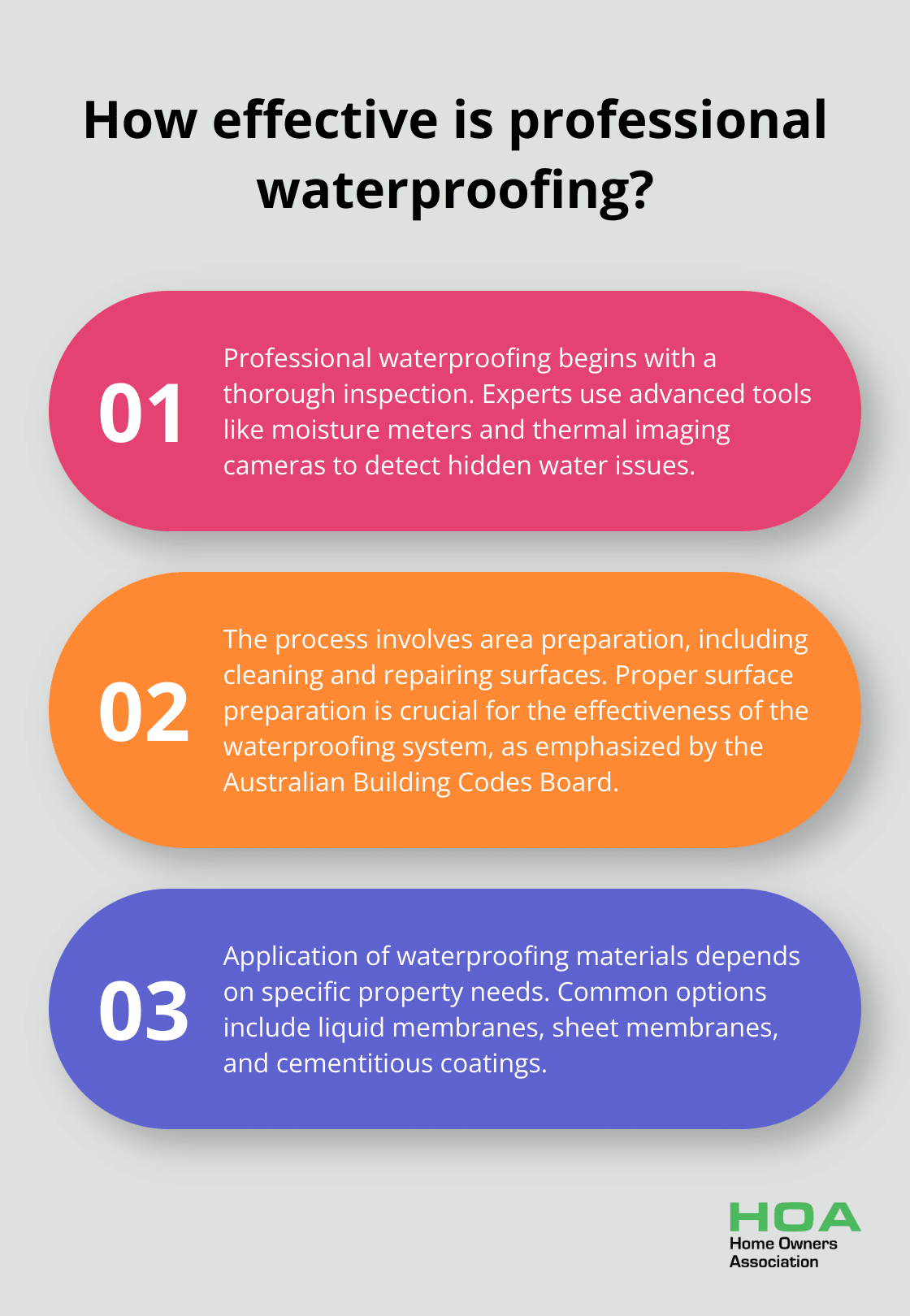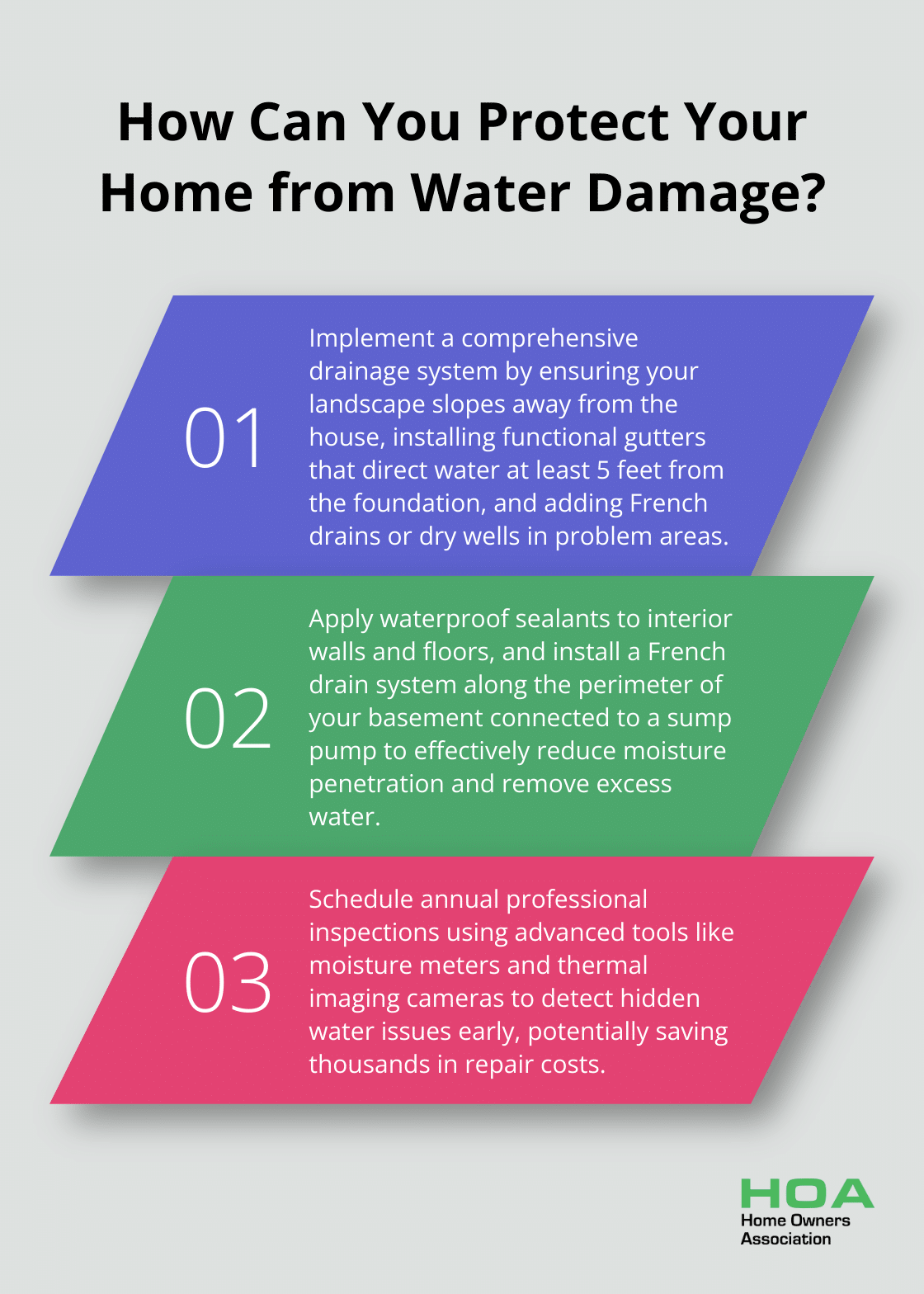
At Home Owners Association, we understand the critical role of home waterproofing services in protecting your property. Water damage can lead to costly repairs and health hazards if left unchecked.
Our comprehensive guide explains various waterproofing solutions and processes to safeguard your home. We’ll explore interior and exterior methods, drainage systems, and the steps involved in effective waterproofing.
What Is Home Waterproofing?
Definition and Purpose
Home waterproofing protects buildings from water intrusion. This essential aspect of home maintenance safeguards properties against structural damage, mold growth, and expensive repairs. Effective waterproofing saves homeowners thousands of dollars in potential damage.
The Significance of Waterproofing
The Insurance Council of Australia’s recent report highlights the impact of water damage on communities, with 14,414 claims filed due to severe floods. This statistic underscores the importance of proper waterproofing. Investing in waterproofing protects your home and secures your financial future.
Vulnerable Areas in Your Home
Certain parts of your house face higher risks of water damage:
- Basements: These underground spaces are exposed to soil moisture.
- Roofs: Poor drainage allows water to seep into attics and walls.
- Windows and doors: Improper sealing lets water in during heavy rains.
Identifying Water Damage Early
Early detection of water damage prevents extensive repairs. Watch for these signs:
- Discoloration on walls or ceilings
- Peeling paint or wallpaper
- Musty odors
- Visible mold growth
- Warped flooring

Prompt action prevents severe consequences and increased repair costs.
Waterproofing Methods
Various waterproofing techniques suit different areas of your home. Interior methods include waterproof sealants and vapor barriers. Exterior waterproofing requires proper grading (ensuring soil slopes away from the foundation to prevent water pooling).
The Importance of Gutters
Clean, functional gutters play a vital role in exterior waterproofing. Extend downspouts at least 5 feet away from your home’s foundation. This simple step stops water from seeping into basements or crawl spaces.
Professional vs. DIY Approaches
While minor waterproofing tasks work as DIY projects, complex water issues often need professional help. Waterproofing costs vary depending on the area, with an average-sized bathroom costing between $500 and $750 to waterproof completely. Professionally waterproofed homes face significantly lower risks of severe water damage compared to DIY methods.
Innovative Solutions
The waterproofing industry continues to evolve. Smart moisture detection systems now provide early alerts for water issues, preventing major problems. Crystalline waterproofing additives (sealing concrete pores) and elastomeric coatings (adapting to structural movement) gain popularity.
As we explore the various types of waterproofing solutions in the next section, you’ll discover how these methods apply to different areas of your home.
Effective Waterproofing Techniques for Your Home
Interior Waterproofing: Your First Line of Defense
Interior waterproofing offers an accessible and cost-effective starting point for home protection. The application of waterproof sealants to walls and floors significantly reduces moisture penetration. Basements benefit from French drain systems installed along the perimeter, which direct water to a sump pump for removal.

Vapor barriers play a key role in interior waterproofing. These plastic sheets prevent moisture from passing through walls and floors. Proper installation dramatically reduces humidity levels and protects against mold growth.
Exterior Waterproofing: Creating a Protective Shield
Exterior waterproofing creates a barrier around your home’s foundation. This process typically involves excavating the soil around your home to apply a waterproof coating or membrane to the foundation walls. While more invasive and expensive than interior methods, exterior waterproofing provides superior long-term protection.
An innovative exterior technique gaining traction is the use of crystalline waterproofing additives. These materials create a waterproof coating, making the structure watertight whenever water comes into contact with concrete.
Drainage: The Unsung Hero of Waterproofing
Proper drainage is essential for any waterproofing system. A well-designed drainage system moves water away from your home’s foundation, reducing pressure on waterproofing materials.
Key components of an effective drainage system include:
- Properly graded landscape that slopes away from the house
- Functional gutters and downspouts that direct water at least 5 feet from the foundation
- French drains or dry wells to handle excess water in problem areas
For homes in flood-prone areas, a backwater valve prevents sewage from backing up into your basement during heavy rains. This simple device can save thousands in potential damage and cleanup costs.
Innovative Solutions in Waterproofing
The waterproofing industry continues to evolve with new technologies. Smart water leak detectors now provide early alerts for water issues, preventing major problems before they escalate. Elastomeric coatings, which adapt to structural movement, have also gained popularity for their flexibility and durability.
Professional vs. DIY Approaches
While minor waterproofing tasks can be DIY projects, complex water issues often require professional help. Waterproofing costs vary depending on the area. Professionally waterproofed homes face significantly lower risks of severe water damage compared to DIY methods.
As we move forward, we’ll explore the step-by-step process of waterproofing your home, from initial inspection to quality checks and maintenance.
The Waterproofing Process: A Step-by-Step Guide
Initial Inspection and Assessment
Professional waterproofing starts with a thorough inspection. Experts examine properties to identify vulnerable areas and existing water damage. They look for signs such as poor or missing insulation, moisture or leak issues, electrical problems, HVAC system defects, and air leaks. This assessment forms the basis of a tailored waterproofing strategy.

Professionals use advanced tools like moisture meters and thermal imaging cameras to detect hidden water issues. These instruments provide valuable insights that visual inspection might miss.
Area Preparation
After assessment, the next step involves preparing the area for waterproofing. This phase includes thorough cleaning of surfaces, removal of debris, and repair of existing damage. Professionals fill cracks and holes, and smooth surfaces to ensure proper adhesion of waterproofing materials.
In basements, this might require the removal of old paint or sealants. Exterior waterproofing often necessitates excavation around the foundation. The Australian Building Codes Board emphasizes the importance of proper surface preparation for the waterproofing system’s effectiveness.
Application of Waterproofing Materials
With the area prepared, professionals apply waterproofing materials. The choice of materials depends on the specific needs of the property. Common options include liquid membranes, sheet membranes, and cementitious coatings. Each has its advantages, and the best choice depends on factors like climate, soil type, and building structure.
In areas with high water tables, professionals might choose a combination of a waterproof membrane and a drainage system. The application process requires precision, with each layer applied according to manufacturer specifications. Proper application is critical to prevent water penetration and building defects.
Quality Checks and Maintenance
After application, professionals perform thorough quality checks. This might include water testing to ensure the effectiveness of the waterproofing. For bathroom waterproofing, a flood test is common (where the area is filled with water for 24-48 hours to check for leaks).
Maintenance is an ongoing process. Regular inspections (ideally annually) can catch potential issues early. Professional waterproofing offers the best long-term protection for homes. The cost of professional waterproofing is often a fraction of potential water damage repairs.
Final Thoughts
Home waterproofing services protect properties from water damage and maintain structural integrity. Comprehensive waterproofing solutions prevent costly repairs, preserve investments, and create healthier living environments. The long-term benefits include increased property value, improved energy efficiency, and peace of mind for homeowners.

Proactive measures to waterproof homes pay dividends over time. Regular inspections and timely repairs form effective waterproofing strategies. Addressing potential issues early helps homeowners avoid significant problems and extends the lifespan of waterproofing systems.
We at Home Owners Association understand the importance of protecting homes from water damage. Our members in Melbourne, Australia, receive exclusive access to trade pricing and discounts on waterproofing materials and services. We provide expert advice and resources to support your waterproofing projects (meeting high-quality standards).





